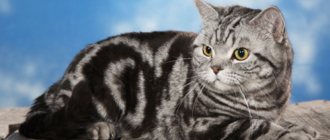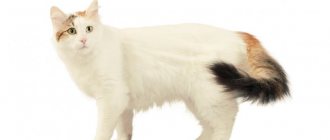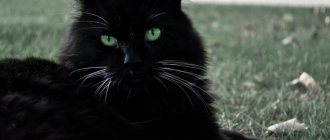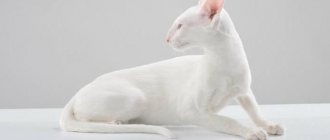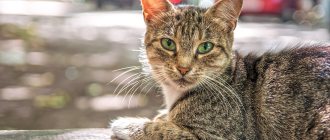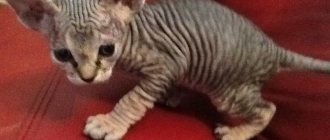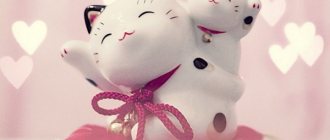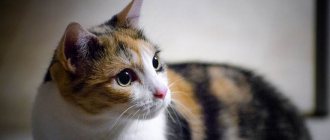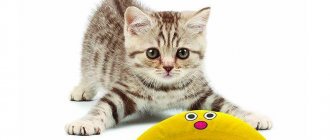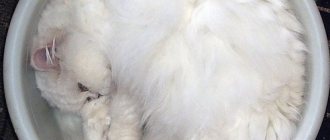What is tortoiseshell color
“Tortoiseshell” is any cat whose coat color combines 3 shades. In most cases it is black, white and red, regardless of which one is dominant. But it’s not just the combination of these colors that matters.
With a tortoiseshell color, the colors are not presented separately, for example, in the form of spots, but are mixed together, forming an intricate, very unusual pattern. When there are 3 colors scattered in the form of independent spots, this color is called tricolor.
Varieties of color
Among the splendor of colors and shades, the main types of color are still distinguished:
1. Torti is a color that resembles small scales superimposed on one another.
2. Calico or calico - a peculiar color created by multi-colored pigmented areas with clear boundaries, located randomly. This color resembles a patchwork quilt.
3. Tortoiseshell with white - a color that combines tortoiseshell with pure white or white with a beige tint. Typically, the upper part of the body is covered with tortoiseshell-colored fur, and the white areas are localized in the lower part of the body. This color is classified as a separate species.
Games of genetics or how the tortoiseshell color came about
The tortoiseshell color has one amazing feature - such an unusual pattern on the coat is characteristic exclusively of females. It is almost impossible to meet a cat with a variegated, multi-colored color, although such a possibility cannot be completely ruled out. The reason for this is a genetic mutation inherited by female kittens from their mother cat. However, such a mutation causes serious difficulties in reproduction.
Genetic features that determine color:
- The chromosomes that determine the sex of an animal are X and Y. XX is a cat, XY is a cat.
- Chromosomes that carry information about color: O - red, o - black.
- The Y chromosome does not carry information regarding the color of the coat; it does not have genes for either red or black colors. And the X chromosome contains only jet black or red shades. For this reason, cats with XY are extremely unlikely to be born with a tortoiseshell-colored coat. For every 3,000 cats with an unusual pattern, there is only 1 male.
Color options in cats with XX chromosomes:
- XO + XO = pure red color;
- Ho + Ho = absolutely black;
- XO + XO = tortoiseshell pattern.
It is not possible to obtain an unusual color with an interweaving of 3 basic colors through targeted selection. This is explained by the fact that the chromosomes have a chaotic arrangement and cannot be ordered.
It is unknown what will happen next, but at the moment, the tortoiseshell color of a cat is a matter of chance, which is not possible to predict, much less predict. Even a cat with a tortoiseshell color can give birth to kittens of a pure shade - black, white or red.
Folklore about tortoiseshell cats
In the folklore of many cultures, tortoiseshell cats are special animals.
Back in Celtic times, cat "turtles" were believed to bring good luck and wealth to homes. Even today, the Irish and Scots believe that stray calico cats are lucky.
In the United States of America, animals with Tortie colors are sometimes called money cats.
The calico cat is also the state symbol of the state of Maryland in the USA. In the late nineteenth century, Eugene Field published a poem for children, "The Duel," also known as "The Calico Dog and the Calico Cat."
Also read signs about tricolor cats.
In Japan, Maneki-neko figures depict calico cats that bring good luck. Japanese sailors often took them with them to protect themselves from misfortune at sea.
Maneki Neko (cat beckoning or inviting cat) is an image of a Japanese Tricolor Bobtail sitting with one paw raised, and is considered a good luck charm among Japanese people around the world, who often keep a statue of this figure in store windows or house windows (most commonly in animals stylized calico color, although gold and black options are also common).
This is due to a legend that tells how a man (usually a priest or a member of the royal family) who owned one of these cats looked up one day and saw his pet calling him. Thinking that the animal might have a message from the gods, he stood up and walked towards it. As soon as he did this, a branch large enough to kill a man fell to where he had been sitting a few minutes ago.
Japanese tricolor bobtails also play an important role in traditional Japanese painting.
In Russian folklore, next to the keeper of the family hearth - the brownie - there is always a tricolor cat.
Owners of tortoiseshell pets often believe that their cats have special personalities and intelligence, but there is little scientific evidence to support this.
However, a 2020 study from the University of California, Davis Veterinary Medicine Teaching Hospital, which surveyed more than 1,200 cat owners, found a link between the "tortoiseshell" pattern and a pet's tendency to be overactive and irritable (hissing, chasing and biting their human companions). According to famed cat expert Jackson Galax, these animals tend to have much more distinct personalities.
Features of tortoiseshell colors: shades and main characteristics
The spotted coat color with the interweaving of 3 basic colors and the formation of an unusual pattern by them has its own subtypes depending on which shade is predominant:
- Black Tortoiseshell : Primary colors are black and red. In places where areas of red pigment are present on the fur, lightened stripes appear. Eye color – copper with a dark tint or dark yellow.
- Chocolate : the main colors are red and chocolate. Pigments have uniform saturation. Eyes - copper or yellow with an orange tint.
- Cinnamon : The base is red and a hint of cinnamon. The specificity of this type of tortoiseshell color is that world standards do not recognize it. The eyes are yellow with varying degrees of shade saturation.
All subspecies of tortoiseshell color are united by almost the same eye color in animals - yellow with different shades.
Types according to the drawing. Depending on what pattern is formed on the wool, there are:
- “Torti” – this type of color is also called “scaly tortoise”. The color of the wool resembles the scales of fish. The basic colors are black and red, represented by small spots located in relation to each other in a checkerboard pattern. It is extremely difficult to find such precise geometry. In most cases, multi-colored spots have a chaotic arrangement. However, the “tortie” color has another distinctive feature - the ratio between red and black is the same. The pattern is motley, the fur is speckled with hairs of different colors.
- "Calico". This type of color has other names - “patchwork” or “calico”. There are no individually dyed hairs, and entire areas of the fur are painted in different colors, usually red or black. The spots can be located separately, overlap each other, merging, or form groups. The most striking representatives with the Calico color are the British, Sphynx and Cornish Rex.
- Turtle on white. The peculiarity of the color is that the fur on the tummy and head in the chin area is white. The entire upper part of the fur has a tortoiseshell pattern, resulting in the impression that a tortoise shell was put on top of the white cat.
In a specific color, the base shades may be spotted or striped. It is extremely rare, but not excluded, that a combination of stripes and spots occurs.
Location of the drawing. Tortoiseshell color is divided into subspecies and depending on the location of the pattern:
- There is a solid turtle - spots of different colors are evenly spaced, as such there is no pattern or pattern.
- Patterned turtle - multi-colored spots form a pattern. These can be various spirals, circles and stripes. The longer a cat's fur, the worse the pattern can be seen.
What is the cat's personality?
Tortoiseshell cats have a unique character. Beautiful animals attract attention and become family favorites, for which they reciprocate.
They have a strong will and very developed jealousy towards their owner. Such cats are irritable and unpredictable, they love independence.
The animals are very affectionate and sociable, and communicate their desires with loud purring, hissing and meowing, more active than those of other breeds.
“Turtles” are characterized by increased playfulness, playfulness and ingenuity. They not only chase toys or a bow with amazing tirelessness. Mischief manifests itself in the fact that they need to suddenly jump out of hiding, throw something from the table onto the floor, for example, a pen or glasses.
The favorite games of hyperactive tortoiseshell cats are hide and seek and chase. They tirelessly chase their family or run away and hide under the sofa. If the owner hid from her, then she will definitely find him.
The tortoiseshell cat is quick to train and accurately performs its duties. She knows how to use the litter box correctly, doesn’t make a mess, and eats her portion.
Multi-colored cats are endowed with a sensitive and vulnerable soul. You can't just offend them. If you do something wrong, you need to talk to the cat and scold it. It would be enough. They are also terrible coquettes, like real women with a unique appearance, and really want to attract attention to themselves.
Character
A tortoiseshell cat will wait for its owner all day, and more if necessary. She waits for the owner at the front door, as soon as he appears near the house, she relentlessly follows him and responds to all calls.
The animal accurately captures the mood and when the owner is busy, it will not be intrusive and will wait for a more opportune moment. And in case of a bad mood and upset feelings, the “turtle” will definitely provide support and regret, caressing and purring. She will calm you down and be silent together in a moment of thoughtfulness. A cat can be a true friend, and not just a pet.
The most common breeds that produce tortoiseshell kittens
An unusual tricolor color is found among representatives of some breeds:
- Persians;
- Siberian;
- Maine Coons;
- bobtails, regardless of subspecies;
- Turkish Angora;
- Cornish Rex;
- orientals;
- Scots;
- Norwegian forest cats;
- sphinxes;
- British.
Each of these breeds has its own characteristics of tortoiseshell color:
- Scottish and British - these breeds have a tortoiseshell color that is recognized as an international standard. But this does not give them an advantage. As practice shows, in most cases experts do not particularly favor representatives of these breeds with a bizarre coat color, and the likelihood that the animal will win at the exhibition is extremely low. But with the acquisition of these cats, on the contrary, it is a completely different story. British or Scottish tortoiseshells with this coat color are bought much more willingly, because cuter creatures simply cannot be found.
- Cornish Rex . Representatives of this breed are endowed by nature with such an unusual coat structure that any color on it will look truly amazing, and tortoiseshell color even more so. In combination with the unique grace and natural aristocracy that is felt in every movement of the cat, the tortoiseshell color adds even more impressiveness, classifying the animal as one of the world of “bohemia.” According to the breed standard, the color of their coat should not combine many shades, but tricolor is very welcome among experts.
- Bobtails . Regardless of the subspecies of the breed, the tortoiseshell color is recognized as a standard and is very welcome in individuals. However, these animals are popular not only due to their often unusual coat color. Bobtails are distinguished by high intellectual abilities and sociability. Unlike most cats, tortoiseshell bobtails are the best and easiest to train.
- Turkish Angora . It is commonly believed that these cats should be pure white as snow and have heterochromia (different colored eyes), however this is not entirely true. Among Turkish Angora cats, tortoiseshell coat colors are often found, which are of great value.
- Maine Coons . These cats attract everyone's attention with their large size and powerful torso. Impressive dimensions, proud, independent look and originality of character against the background of tortoiseshell color make Maine Coons especially attractive to cat lovers and even a little mysterious.
- Sphinxes . Surprisingly, but true: a breed such as the Sphynx, characterized by a complete absence of hair, can have a tortoiseshell color on its bare skin. Despite the non-standard appearance, the unusual lack of fur, “naked” individuals have recently become increasingly popular. The reason is the incredibly flexible, easy-going nature of the animals, their friendliness and affection towards the owner and all household members.
- Orientals . If in other breeds experts disdain tortoiseshell colors, although this is allowed by the standard, then in Orientals this color is only welcome. The breed standard allows for mixing 4 colors. These cats are incredibly smart, wise in an oriental way and, despite their outward independence and independence, they really love communication with people and even need it.
- Persians , exotics . These breeds occupy a leading position in choice as pets. Tortoiseshell color is not common among them, but it cannot be called rare either. Such an unusual combination of colors on long fur makes cats incredibly beautiful and attractive.
- Norwegian . Among all the breeds, it is generally accepted that the Norwegian Forest cat in this color looks the best. Thanks to the thick and long coat, the color transitions and intricate lines formed by them look especially elegant and unique.
Outbred murki.
Tortoiseshell colors are also found among yard cats.
What is most interesting is that it is among outbred murkas that animals with an intricacy of several colors in their coat color are most often found.
Description of color
With this coat color, bright spots of two colors are visible throughout the animal’s body: most often red and black. Both of them are also necessarily present on the cat's paws. If you look closely at the photo of turtles, you can see a bright triangle on the animal’s face - this is a flame, another sign of a tortoiseshell color.
Usually not only the fur, but also the skin of the animal is multi-colored. Thanks to this, even a hairless sphinx can be a turtle. Also, along with an unusual fur coat, there may be eyes of two colors.
Character and behavioral characteristics of tortoiseshell cats
Undoubtedly, it is not the color that dictates the character traits and behavior of an animal. Nevertheless, many years of observations have led to the conclusion that, regardless of breed, almost all cats with a similar spotted color have a number of common traits in character and behavior:
- Complaisance and friendliness . Animals are incredibly friendly and flexible in nature. The owner will always be able to come to an agreement with his pet, resolving any misunderstandings at the beginning of their occurrence.
- Pride and independence . Tortoiseshell cats, despite their close friendship with people, are distinguished by their independence and pride. Animals know exactly what they want, and nothing and no one will force them to do anything without their desire.
- Perseverance, bordering on incredible stubbornness , is another common character trait that is inherent in almost all tortoiseshell cats. They are so stubborn that they can persuade even a person.
- Tray training. There is one more feature that unites all “turtles” - despite the fact that cats are very smart and savvy, it is extremely difficult to accustom them to a litter box. Individuals with a tortoiseshell color may simply not agree with the place that the owner has allocated for them. It is useless to argue with these stubborn and persistent animals. It’s easier to move the tray to a place chosen by the cat.
However, at their core, tortoiseshell cats are very sweet, friendly creatures that are unlikely to cause any inconvenience to their owners and household members.
Genetics of tortoiseshell coloration
A separate feature of the tortoiseshell color is that it is almost never transmitted to cats. Basically, only cats can boast of such a fur coat. This is due to the genotype, in which only the X chromosome can carry coat colors.
There are exceptions: in order for a cat to have tortoiseshell hair, there must be an unusual chromosomal abnormality in its DNA makeup. Such animals have three chromosomes - XXY. Usually these cats do not give birth, but there is an exception even here.
In 2014, an unusual tricolor and very fertile Maine Coon was born in Germany, which was named Mesomix. His chromosome set (HUKHU) is even more unusual, which is why scientists call him a chimera cat.
Signs and superstitions
Cats have always been surrounded by a veil of mystery and mysticism. From time immemorial they were considered guides to the other world and were often accused of aiding sorcerers and witches. Therefore, it is not at all surprising that such unusual, rarely seen animals with a tortoiseshell color are considered mystical. There are many signs and superstitions in different countries, but they all have one thing in common - a cat with a tortoiseshell color is a symbol of good luck:
- England . In this country, it is not customary to just give a tortoiseshell cat as a symbol of good luck and happiness. You must definitely give at least a small change for it, thus paying for further success, peace and love in the house. If a kitten with an unusual color comes into the house on its own, you also have to pay for happiness. At the intersection of 4 roads you need to put coins: it doesn’t matter what the amount is.
- Russia . In this country, any cat, regardless of breed and coat color, brought happiness and peace to the house. In Ancient Rus', cats protected the house from evil spirits, protected from evil spirits and enemies. It was especially good if the color of the animal’s fur matched the color of the owner’s hair. Then peace, comfort and love always reigned in the house, and good luck favored the household. In this regard, tricolor cats were considered universal. There are so many shades combined in the color of their coat that they will suit any hair color.
- Japan . In this country, cats are respected and loved by everyone, and animals with a tortoiseshell color are revered with greater honor. Figures with their image are placed near the entrance to each house, hoping that they will bring good luck. The Japanese prefer to have bobtails as pets, relying on the tortoiseshell color, because they protect the house and protect household members from evil spirits and bad thoughts of enemies.
- Arab countries . In the East, cats are held in special esteem, and they are more preferred as pets than dogs. Tortoiseshell cats protect against adversity, fire and theft.
- America . If in most countries tricolor cats are symbols of good luck, in America they are associated with money and material wealth. There is a belief in this country that if a tricolor cat comes to your house, it means that you can soon expect sudden enrichment. American bobtails are especially popular in the United States.
Also watch a video about tortoiseshell cats:
Breeds
Tricolor coats are common to many breeds. And even ordinary yard cats can often boast of an unusual fur coat. Among domestic breeds, turtles can most often be found among:
- Siberian cats;
- Japanese bobtails;
- sphinxes (Canadian and Don);
- Maine Coons;
- British;
- Scottish fold cats;
- Persian cats;
- rex (Ural, Selkirk, Devon, Cornish);
- American Shorthair;
- and among many others.
Thanks to genes, a tricolor color can appear in almost any cat, regardless of its breed. But the standards of some breeds are so strict that sometimes this color is not acceptable. In addition, various variations with tortoiseshell color are often limited.
For example, a British cat can have eyes of any color, but the undercoat must match the main color. The Kurilian Bobtail should not have diluted shades of black in its coat, and the Neva Masquerade cat must have blue irises.
Shaded gold and silver color
Many chocolate, black and purple animals have a silver tint. This covers the pet's paws, belly, collar and chest.
As for the golden color or copper color, as breeders also say, it is rare. In this case, the coat is darker at the base, and at the end the hairs appear golden. It is impossible to confuse such pets with others, if only because they have a black tip of their tail, paw pads, and also eyeliner around their eyes. People call this type of cat the domestic chinchilla or the ticked British cat. This color of a British cat is not very rare, because breeders know well how to get it.
British character
The main character traits are:
- independence;
- patience;
- touchiness;
- stubbornness.
Such pets are not very affectionate and can even scratch a person.
A British woman will not sit in the arms of a man, even if he is her owner. You can pet a cat only in that situation if she herself wants it. Since cats are willful, they do not ask their owners for food. Pets prefer to sit next to the bowl and wait until they are fed. They don’t respond to “kiss-kiss” either, only to their own name. The tri-colored Briton is independent. Even small kittens, following the example of their mother, begin to independently go to the place designated for the toilet. Cats are also known for their cleanliness, so they wash themselves often. In addition to the advantages, there are also unattractive aspects of the character. Cats love to throw objects off surfaces and bite and scratch their owners, especially kittens. They do not hesitate to climb into and explore bags, packages and boxes.
